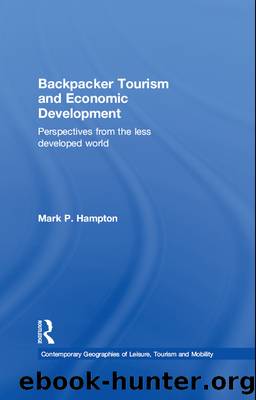Backpacker Tourism and Economic Development by Unknown

Author:Unknown
Language: eng
Format: epub
ISBN: 1172890
Publisher: Taylor & Francis Group
Cape Town, South Africa
The African region has some history of independent travel since the 1960s (especially North Africa, such as the coast of Morocco), with some of the early overland firms discussed in Chapter 1 diversifying from their Asian routes and starting to bring tourists overland across Africa. At the same time, several African governments planned and developed mass international tourism in countries such as Kenya. Generally, independent travel and backpacking in Africa has been slow to take off, when compared with other world regions such as South-East Asia or Latin America. This may be due to a combination of factors: relatively expensive air travel from tourist-generating regions (and fewer major world airline operators); poor infrastructure in many countries, such as roads and transport systems; the overall image of sub-Saharan Africa as being a region struggling with debilitating poverty; and in some countries, very high crime levels (or at least perceptions of this). Bell (2005) calls this common tourist perception of Africa as being dangerous the ânervous gazeâ, reworking Urryâs well-known idea of the âtourist gazeâ (Urry, 2002).28
For South Africa, the relatively recent development of backpacker tourism has been affected by its recent history and, specifically, the very limited tourism and the travel constraints during the Apartheid era, although some early backpacker businesses opened in the late 1980s (Heer, 2007).29 Post-1994, however, international tourism to South Africa has boomed. Backpackers have arrived in significant numbers, and accommodation and other facilities have opened in response to this growing demand. By 2006, a Lonely Planet survey had placed South Africa in the top 20 world backpacker destinations.30 Visser (2004: 286) argues that although small-scale guest houses began to emerge in the late 1980s and 1990s, the main boom in specific backpacker hostels was from the late 1990s with the growth of international tourism to South Africa.
International arrivals to South Africa increased from around 3.9 million in 1994, to 6.8 million by 2004, and over 8 million in 2010 (Department of Tourism data). A Department of Trade and Industry survey in 2007 found around 90,000 international backpackers arriving per year (DTI, 2007). That survey also listed around 100 backpacker accommodation units/hostels at that time in Cape Town. The growth of backpacker tourism to the country has been analysed by C. Rogerson (2007a,b; 2010) and Visser (2004), and most research dates from the first decade of the twenty-first century. The earliest work on backpackers in South Africa appears to be a student dissertation on Cape Town (Courtney-Clarke, 2001).
The city of Cape Town is what C. Rogerson (2007a) dubbed South Africaâs âbackpacker capitalâ, with the largest concentration of backpacker facilities. In 2004 the city hosted around a third of all backpackers in the country (Visser, 2004). Like Bangkok, Cape Town is also one of the main international points of arrival for tourists and a staging post for trips on many routes around the country and into neighbouring southern African countries. Although backpacker facilities such as hostels (âlodgesâ) exist around the city, the main enclave lies on and around Long Street near the central business district.
Download
This site does not store any files on its server. We only index and link to content provided by other sites. Please contact the content providers to delete copyright contents if any and email us, we'll remove relevant links or contents immediately.
International Integration of the Brazilian Economy by Elias C. Grivoyannis(91364)
The Radium Girls by Kate Moore(11924)
Turbulence by E. J. Noyes(7939)
Nudge - Improving Decisions about Health, Wealth, and Happiness by Thaler Sunstein(7620)
The Black Swan by Nassim Nicholas Taleb(7014)
Rich Dad Poor Dad by Robert T. Kiyosaki(6412)
Pioneering Portfolio Management by David F. Swensen(6228)
Man-made Catastrophes and Risk Information Concealment by Dmitry Chernov & Didier Sornette(5923)
Zero to One by Peter Thiel(5689)
Secrecy World by Jake Bernstein(4648)
Millionaire: The Philanderer, Gambler, and Duelist Who Invented Modern Finance by Janet Gleeson(4381)
The Age of Surveillance Capitalism by Shoshana Zuboff(4213)
Skin in the Game by Nassim Nicholas Taleb(4164)
Bullshit Jobs by David Graeber(4097)
The Money Culture by Michael Lewis(4080)
Skin in the Game: Hidden Asymmetries in Daily Life by Nassim Nicholas Taleb(3932)
The Dhandho Investor by Mohnish Pabrai(3703)
The Wisdom of Finance by Mihir Desai(3657)
Blockchain Basics by Daniel Drescher(3510)
